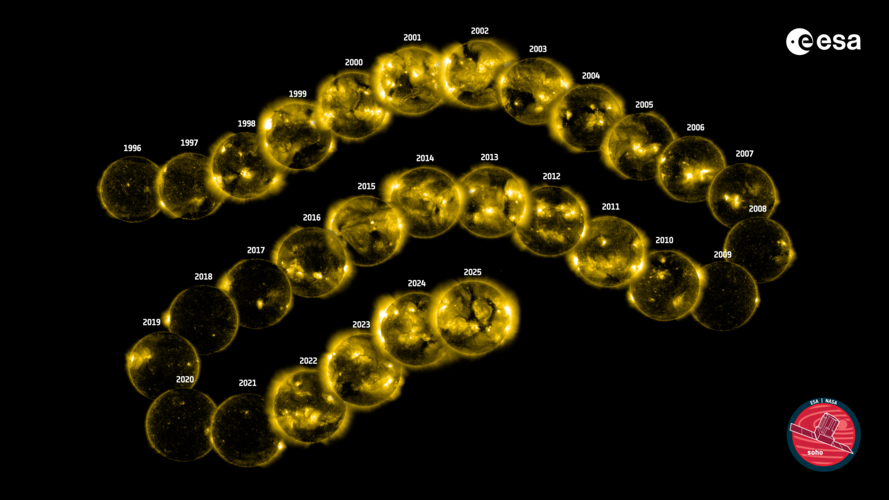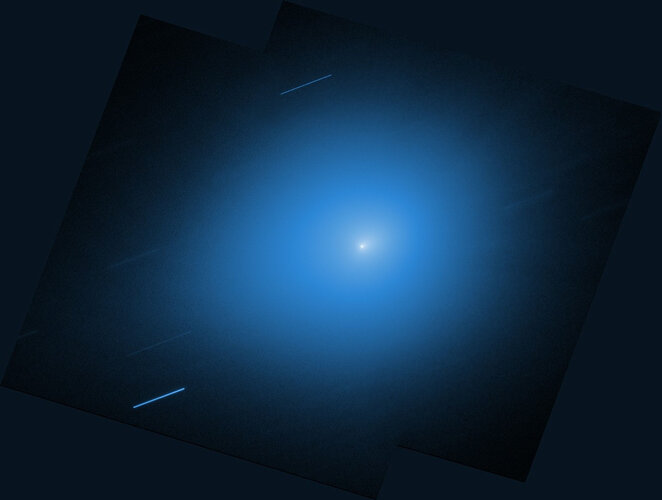
Copernical Team
Week in images: 01-05 December 2025

Week in images: 01-05 December 2025
Discover our week through the lens
Astrobee: AI-guided robot navigates space station corridors with improved speed and safety
Verifying that you are not a bot
Hubble reobserves 3I/ATLAS
 Image:
Image:
The NASA/ESA Hubble Space Telescope reobserved interstellar comet 3I/ATLAS on 30 November with its Wide Field Camera 3 instrument. At the time, the comet was about 286 million km from Earth. Hubble tracked the comet as it moved across the sky. As a result, background stars appear as streaks of light.
Hubble previously observed 3I/ATLAS in July, shortly after its discovery, and a number of observatories have since studied the comet as well. Observations are expected to continue for several more months as 3I/ATLAS heads out of the solar system.
For the latest updates and FAQs related to comet 3I/ATLAS, see
Earth from Space: Singing dunes and mysterious lakes
 Image:
This Copernicus Sentinel-1 image features part of the Badain Jaran Desert in northwestern China.
Image:
This Copernicus Sentinel-1 image features part of the Badain Jaran Desert in northwestern China. Italian Earth observation fleet gains eight new IRIDE satellites
 Italy's IRIDE Earth observation programme has expanded with the launch of eight Eaglet II satellites, adding a second constellation to the growing national fleet. The spacecraft rode into orbit on a Falcon 9 mission that lifted off from Vandenberg Space Force Base in California at 19:44 CET on 28 November, with deployment completed about an hour after launch and signals from all satellites later
Italy's IRIDE Earth observation programme has expanded with the launch of eight Eaglet II satellites, adding a second constellation to the growing national fleet. The spacecraft rode into orbit on a Falcon 9 mission that lifted off from Vandenberg Space Force Base in California at 19:44 CET on 28 November, with deployment completed about an hour after launch and signals from all satellites later Greece deploys first national ICEYE radar satellites for disaster monitoring
 Two new ICEYE radar satellites have entered service under Greece's National Small Satellite Programme, expanding the country's capacity to track floods, wildfires, landslides and other hazards as well as areas of security interest on land and at sea.
The pair of synthetic aperture radar spacecraft were launched on 28 November 2025 on SpaceX's Transporter-15 rideshare mission from Vandenber
Two new ICEYE radar satellites have entered service under Greece's National Small Satellite Programme, expanding the country's capacity to track floods, wildfires, landslides and other hazards as well as areas of security interest on land and at sea.
The pair of synthetic aperture radar spacecraft were launched on 28 November 2025 on SpaceX's Transporter-15 rideshare mission from Vandenber Gels may have given early Earth chemistry a place to organize into life
 An international team from Japan, Malaysia, the UK, and Germany has proposed that life on Earth may have emerged within sticky, surface-bound gels that formed before the first cells. The researchers argue that these prebiotic gels, attached to mineral or other surfaces, could have provided both structure and chemical environments that helped early chemistry progress toward biology.
The tea
An international team from Japan, Malaysia, the UK, and Germany has proposed that life on Earth may have emerged within sticky, surface-bound gels that formed before the first cells. The researchers argue that these prebiotic gels, attached to mineral or other surfaces, could have provided both structure and chemical environments that helped early chemistry progress toward biology.
The tea Small satellite mission targets maritime activity monitoring from orbit
UK plasma thruster test positions Pulsar Fusion for larger satellite propulsion
 Pulsar Fusion and partners have tested what they describe as the largest space plasma engine yet fired in Britain, designed to provide high-thrust in-space propulsion for heavier satellites. The engine, which the company reports is roughly ten times larger than its previous plasma thrusters, was demonstrated at the University of Southampton on 29 January in a large vacuum chamber to replicate on
Pulsar Fusion and partners have tested what they describe as the largest space plasma engine yet fired in Britain, designed to provide high-thrust in-space propulsion for heavier satellites. The engine, which the company reports is roughly ten times larger than its previous plasma thrusters, was demonstrated at the University of Southampton on 29 January in a large vacuum chamber to replicate on NASA extends ISS National Lab management contract through 2030
 The Center for Advancement of Science in Space will continue to manage the International Space Station National Laboratory for at least another five years, CASIS announced on Thursday.
CASIS has managed the ISS National Lab since 2011, after Congress created it to enable researchers to build a "robust market" in low Earth orbit by leveraging the unique environment that exists in space, CAS
The Center for Advancement of Science in Space will continue to manage the International Space Station National Laboratory for at least another five years, CASIS announced on Thursday.
CASIS has managed the ISS National Lab since 2011, after Congress created it to enable researchers to build a "robust market" in low Earth orbit by leveraging the unique environment that exists in space, CAS 